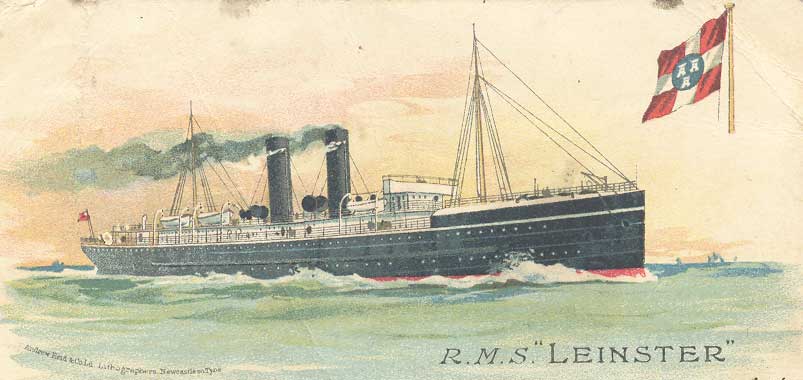Tim Magennis of the Dublin Bay OGA reflects on the worst Irish Sea disaster which occurred on October 10, 1918.
No more efficient system of transporting mail across the Irish Sea in the century up to the end of World War 1 could have been conceived than that carried out by the City of Dublin Steam Packet Company, in it’s time the oldest steamship packet company in the world. And no more timely and well-run ship existed at the time than the company’s ‘RMS Leinster’, under the command of Captain William Birch, holder of the fleet’s senior title of Commodore. When he assembled his senior officers on the morning of October 10, 1918 in Kingstown (present-day Dun Laoghaire) Harbour prior to his regular sailing to Holyhead, he was a worried man. He had just failed, yet again, to get the authorities to provide a naval escort for the 2 hours 45 minutes crossing, and he had reason to believe reports that German submarines were increasingly active in the Irish Sea, even though the general belief was that the end of the dreadful war was, indeed, approaching.
On top of that was a general consensus among informed maritime sources that the small number of German submarine commanders that had survived the virtual destruction of their once proud fleet were, if anything, more determined than ever to strike a blow for the Fatherland. Two other factors were playing on the captain’s mind: the responsibility of ferrying 22 postal workers and their 250 bags of mail to a punctual arrival in Wales in terns of contract and, most significantly, the presence on his ship of 489 military personnel that effectively transformed ‘Leinster’, and not for the first time, into a troop ship and a legitimate target for any enemy marauder. It was just before 0900 hrs when the 771 passengers and crew were secured on board and the ‘Leinster’ steamed out of Kingstown Harbour of refuge, and set a SE course to round the Kish Light 11 miles distant. The wind was strong and the seas rough and getting rougher as Leinster approached the shallows of the Kish Bank. It was 0945 hrs when Commander Robert Ramm of UB-123 fired the first of three torpedoes. The first missed its target but the second was a direct hit in the area where the postal workers were already sorting the mail. Most of the workers were killed instantly. The ‘Leinster’ swung around to port, almost facing back to harbour, and then the second torpedo struck, holing her on both sides. This one struck in the area of the boiler room. There was a massive explosion and ten minutes later, the ‘Leinster’ was on the bottom. Those in the lifeboats or in the sea had to wait several hours before rescue arrived on the Kisk Bank.
Many died of hypothermia in the cold and wild sea. The death toll in the worst ever disaster in the Irish Sea was 501. The military authorities in charge of censorship did their work well and very little news of the disaster was allowed to reach the Press. Down all the years since then, the ports of Holyhead and Dun Laoghaire have grown close as a result of faithful commemorations of the disaster that struck them on that bleak November morning. Some years ago a group of local divers succeeded in retrieving Leinster’s starboard anchor and mounting it in a public area on Dun Laoghaire’s main promenade road overlooking the Kish Bank out in the Bay. Irish postal workers down the years have continued to salute their fallen members, only one of whom survived the sinking of the Royal Mail ship.
Inspired by a suggestion made by the OGA to local Areas of the Association to seek out relevant promotions in their own regions suitable to honour the OGA 50th anniversary in 2013, the Dublin Bay OGA Area sought the interest and support of the Communications Workers’ Union, which represents postal workers in Ireland. The answer was as immediate as it was generous. And so a new trophy was presented for the first time alongside Dublin Bay OGA’s prized Asgard Trophy in the list of prizes for their annual June Bank Holiday sailing programme in the River Liffey’s always welcoming Poolbeg Yacht and Boat Club. The sterling silver Leinster Plate, crafted in Dun Laoghaire, her last port of departure was inaugurated in 2013 and sailed for in the years ahead in Dublin Bay, following the exact course of ‘RMS Leinster’ to her final resting place.
Ack: Roy Stoke’s Death in the Irish Sea
Tim Magennis, Dublin Bay OGA President, 2013 – 2016
